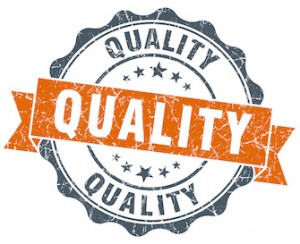EDITORIAL NOTE: What appears below is based on remarks by Manny Schecter, IBM’s Chief Patent Counsel, at the USPTO Patent Quality Summit on Wednesday, March 25, 2015.
_______________
 I speak to you today from the perspective of a large corporate patentee in the technology sector that rigorously enforces its patents but that is also frequently subject to enforcement by others who are typically non-practicing entities.
I speak to you today from the perspective of a large corporate patentee in the technology sector that rigorously enforces its patents but that is also frequently subject to enforcement by others who are typically non-practicing entities.
Let me begin by saying these two words: Patent Quality. Two words that individually we all know what they mean, but you put them together and they cause lots of confusion. So let me clarify. Patent Quality is not invention quality and it is not patent value. Invention quality, patent quality and patent value are all different. They relate to each other. They may impact each other. But patent quality is its own unique thing.
So what is patent quality? I think at its core, when we think of patent quality we think about whether a patent satisfies the statutory requirements. Is it valid? That is where we start, but there is more. We need to remember this: we cannot pick up a patent and quickly and simply determine whether that patent actually meets those statutory requirements. If we could, this would be a much easier discussion. But we simply cannot.
So where does that take us? We have to look for indicia that the applicant and the examiner, working together, facilitated robust patent examination such that all of the issues we think might need to be addressed in a patent application are indeed addressed. Notice I said applicant and patent examiner. That is because I believe patent quality is a shared responsibility. It is not strictly on the USPTO.
Now, let us turn to some perspective. I started by mentioning my perspective of that of a large corporate patentee. What does patent quality mean to my client? It means that, years after we obtain a patent, when we need to leverage that patent, and we dust it off, we have confidence that it is going to survive all of the scrubbing that it is going to be put through, not only by my own organization, but by my opponent. Whatever the matter is, whatever the reason we are leveraging the patent, we need to have confidence in the patent.
Now you ask, “Manny, earlier you said that your client frequently has patents asserted against it. So if you improve the confidence in your own patents, if the patent office and the applicants work together to improve patent quality, aren’t you at the same time going to improve the confidence of your opponents in their patents?” My answer is based on many if not most of the patents I see asserted against my client. I believe that if we raise patent quality, many of the patents that are asserted against my client would not issue in the first place. Or if they issued, they would issue with clearer and narrower claims that would be less of a threat to my client and less disruptive to my client’s business. It is simple as that.
Do the perspectives stop there? I don’t think so. Let us consider our perspective as members of the public. We should want an efficient patent system. This is our patent system. We want issues in the patent office to be addressed as early in the patent life cycle as possible. It is not healthy for members of the public to expend resources to design around patents that are meritless. It is not healthy for members of the public to have to incur expense to defend themselves against patents that are meritless.
I want to make one last point. Many years ago, a USPTO official, who has long since departed the USPTO, remarked to me that with respect to patent quality, the only thing that matters is whether the best prior art is of record. Whether the best prior art is of record is important, it may even be the most important thing with respect to patent quality. We can debate that over the next two days, but it is not the only thing and it is not the only important thing. One other thing that is really important to me is clarity of scope of the patent. We need to ensure that when a patent is granted the scope of the patent afforded to it by the USPTO is clear and on the record. We need to build the record to do that. Ambiguity is never going to be completely eliminated. In fact, the courts have told us some ambiguity in patents is acceptable. But ambiguity is also the fuel for disputes. If we can build the record during prosecution in a way that reduces ambiguity, we will reduce the disputes that occur down stream. It only stands to reason.
So let me recap what I said. Patent quality is about validity, and more, including all of the pillars and items laid out by the USPTO. I am really glad we are having this discussion. It can only foster good things. I also told you that patent quality is about more than just prior art and that every one of us has a stake in improving patent quality. Thank you.

![[IPWatchdog Logo]](https://ipwatchdog.com/wp-content/themes/IPWatchdog%20-%202023/assets/images/temp/logo-small@2x.png)

![[Advertisement]](https://ipwatchdog.com/wp-content/uploads/2024/04/Patent-Litigation-Masters-2024-sidebar-early-bird-ends-Apr-21-last-chance-700x500-1.jpg)

![[Advertisement]](https://ipwatchdog.com/wp-content/uploads/2021/12/WEBINAR-336-x-280-px.png)
![[Advertisement]](https://ipwatchdog.com/wp-content/uploads/2021/12/2021-Patent-Practice-on-Demand-recorded-Feb-2021-336-x-280.jpg)
![[Advertisement]](https://ipwatchdog.com/wp-content/uploads/2021/12/Ad-4-The-Invent-Patent-System™.png)







Join the Discussion
3 comments so far.
Gene, but not Gene Quinn
March 30, 2015 08:10 amThere is one process step that should stand above all others as a necessary quality procedure and, as you might expect, it is disliked by most and will meet large resistance (but only at first): coworker/colleague/collaborator review of work product before it goes out the door. This is, in my opinion, the No. 1 quality improvement step that is applicable across many, many disciplines. It may also lead to an interesting management dilemma: “Who reviews the reviewer?”
Anon
March 29, 2015 06:19 pmMark,
My background also utilize the “manufacturing” sense, but be careful with gross measurements as the variables may create more noise than signal.
Mark Nowotarski
March 29, 2015 02:30 pmComing from a manufacturing background, “quality” to me means focus on the process. If the process is in control, then the product will be consistently high quality. From a practitioner perspective, that means we have written checklists for all basic procedures (“file application”, “receive office action”, etc.) and quantitative metrics for determining the quality of what we produce (e.g. quality of “responses to a rejections” is measured by number of allowances we get after said responses). If a metric goes out of control, we go back and look at the process to see how it can be improved. See “Making progress with difficult patent applications” for more examples.https://ipwatchdog.com/2010/12/19/making-progress-with-difficult-patent-applications/id=13828/
I’d be curious to hear how other practitioners address the issue of quality of their organization’s work product as well.